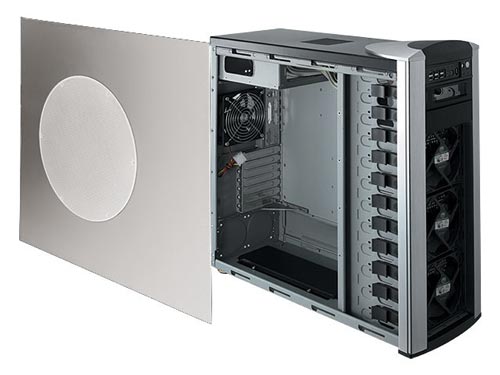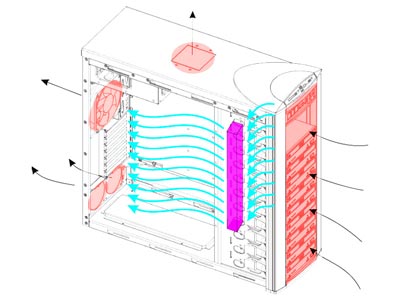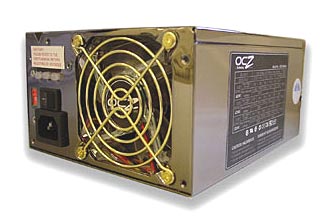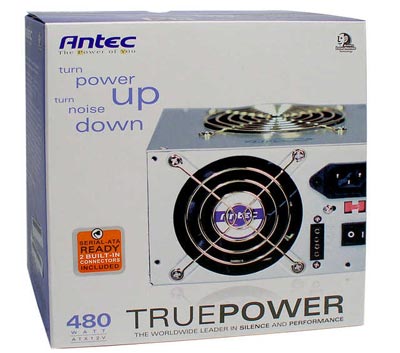Overclocking Buyer's Guide - August 2004
by Wesley Fink on July 27, 2004 11:24 AM EST- Posted in
- Guides
Case and Power Supply
Computer Case
Recommendation: Coolermaster CM Stacker (STC-T01)Price: $175 shipped
Overclockers tend to swap components at a dizzying rate, always looking for something that will run just a little faster or perform a little higher on a competitive benchmark. Since components are likely to be swapped a lot, a case should be as flexible as possible, providing for future components as well as those you might use today. Cooling is also a huge concern for overclockers, so a case that provides exceptional cooling is also a plus.

The 1.0 mm Steel Plate and Aluminum alloy Coolermaster CM Stacker is a case that fits the bill for the overclocker. Not only does it support 11 5-1/4" devices, it also supports both standard ATX and coming BTX designs. The case comes with conversion instructions for mounting a BTX motherboard. You also get support for either one or two standard ATX power supplies, and up to 8 internal fans, in addition to a unique optional crossflow fan.

Coolermaster cases are still some of the best for build-quality that you will find anywhere, and the CM Stacker is the most flexible case design that we have even seen. Whatever your particular desires in overclocking your system, you are likely to find a way to do what you need to to do with the CM Stacker.

You have to see the flexibility of the CM Stacker to believe it.
Power Supply
Recommendation: OCZ Power Stream 520WPrice: $150 shipped
The first thing that most overclockers learn is that the power supply does matter, because the first wall most overclockers run into is the inadequate power supply that came with their white-box computer. Overclocking demands much more of a computer system than running the system at stock speeds. If you think a Prescott at 3.4Ghz demands wattage, then you quickly realize a Prescott at 4.0Ghz demands even more power. The same is true of video cards. If a 6800 Ultra Extreme demands a decent 470W power supply, then you will need even more power when you overclock that 6800 Ultra to higher GPU and memory speeds.
You also quickly learn that all power supplies are not created equal. Most power supply ratings are combined ratings, as regular readers have learned in Power Supply reviews at AnandTech. This means that as some of the power supply rails are driven, other rails drop in power, and may end up supplying less than ideal power under stress. The very best power supplies individually control the power rails. They, therefore, usually handle the stress of overclocking much better than a PS with a combined rating. These are the power supplies that are most coveted by overclockers.

A superb example of a power supply geared to overclockers is the new OCZ Power Stream 520. It was designed from the ground up for overclockers, and features individual rails that are even tweakable for higher output or exact values. There are even LEDs on the rear of the black chrome case that tell you if the PS is operating in spec, under spec, or over spec. These same LEDs can even be used to tweak individual rails for optimum power.
520W sounds like a lot of power and it is, but truthfully, this power supply would probably be rated at 700 watts by a manufacturer who was trying to impress with specs. The 520W rating is conservative and this PS can easily handle almost anything an overclocker wants to throw at it. While the OCZ Power Stream are new to the market, they have quickly become favorites of the extreme overclocking community.
You will also find a stock 24-pin ATX power connector that will work with the new Socket 775 motherboards and servers, as well as a 24-pin to 20-pin adapter to use with motherboards requiring a standard 20-pin connector. There are also extra long SATA and 4-pin Molex connectors to power anything you might put in a full tower case or the CM stacker, as well as special heavy duty cables for the demands of hard drives and the latest high-end video cards. You can find out more about the Power Stream power supplies at the Power Stream product page.
Alternative: Antec True Power 480W
Price: $87 shipped
If $150 for a top power supply seems a bit rich for your budget, there is a very good alternative with the Antec True Power 480. The True Power series features individually powered rails, unlike the lesser Antec power supplies, which brings excellent stability to power-hungry overclocking.

The True Power series, in particular, is one of the most trusted power supplies among enthusiasts, and it will provide your overclocked system with stable power and some reserve for overclocking. While a good quality 350W or 400W power supply might do the job for processors and video cards at stock speeds, you will definitely need a high-quality power supply like the True Power 480 if you plan to overclock.
If you cannot find the lowest prices on the products that we've recommended on this page, it's because we don't list some of them in our RealTime pricing engine. Until we do, we suggest that you do an independent search online at the various vendors' web sites. Just pick and choose where you want to buy your products by looking for a vendor located under the "Vendor" heading.










40 Comments
View All Comments
vaeren - Thursday, July 29, 2004 - link
Well I decided to try the EVGA card for 389 from www.buyxg.com Went to the site, lo and behold the card is stated there at 389. I go to buy it and it rings up 409. Ok, so I see it's backordered and I send them an e-mail basically asking them to honor the homepage. They essentially tell me that I don't know what I'm talking about and the page is now fixed. I don't think I'd recommend them in the future as an accurate price guideline. Granted Anandtech doesn't guarentee prices, but I think poor business practices should be addressed.PrinceGaz - Thursday, July 29, 2004 - link
Just a slight error in the article regarding the Mobile XP 2500+"However, the FSB speeds and multiplier are also a fortunate accident on the 2500+, since 11X is also the same multiplier as the top 3200+ Athlon XP. Since the 2500+ runs at 166 FSB, 3200+ performance is often as easy as setting the FSB to 200 from the default 166. Most, but not all, 2500+ can easily reach 3200+ speeds. The 2600+ mobile also looks even more promising as an overclocker, though we have not yet tested it. With specifications of the same 45 watt power consumption, a 12 multiplier, and 166FSB, it is hard not to be tempted when it is less than $10 more than a 2500+."
The desktop version of the 2500+ does run at 166*11 (1833 MHz), but the Mobile version has a 133FSB default. Thats not a problem because as you say in the article, they are unlocked so you can set the FSB and multiplier to whatever you like. But you will need to lower the multiplier with the Mobile 2500+ to run it as a 3200+.
The Mobile 2600+ is probably a much better choice because it has a much higher default speed than you'd expect,
Desktop 2500+ 166*11 = 1833 MHz
Desktop 2600+ 166*11.5 = 1917 MHz
Mobile 2500+ 133*14 = 1867 MHz (1.45V)
Mobile 2600+ 133*15 = 2000 MHz (1.45V)
the Mobile versions of both chips have a slightly higher clock speed than the desktop versions to compensate for the lower default FSB. In particular the Mobile 2600+ is a whole 133MHz faster than the Mobile 2500+ to compensate for the ever diminishing returns of higher multipliers.
For an overclocker that means the Mobile 2600+ is an unlocked chip that is guaranteed to run easily at 2GHz while still at 1.45V. That pretty much guarantees it will reach 2.3GHz, and maybe as much as 2.5GHz at the desktop 1.65V. And you can always give it a little extra juice if that isn't enough :)
roostercrows - Thursday, July 29, 2004 - link
#2 bluedarti did some research about a month ago on the synthetic diamond heatsinks and it seems they have been used for many decades (40+ years)."Swans" research was extremely helpful. i would like to know what material you are coating the diamonds on and also if you are infiltrating the diamonds with copper etc,(if you are makeing one you know what i mean). i have one ordered using tungsten and 6%cobalt as the base metal, 1mm to 1.5mm thick. i'm glad to hear someone else is playing around with this. btw, the specs that i looked at were 7x better than silver, using single crystal. also, what size are you using and are you using an existing product or are you starting from scratch? have fun.
Pathogen03 - Thursday, July 29, 2004 - link
I like the writting style and thought processes behind the review.. It definetly was the most fun, and most detailed one ive seen.BUT,
Your Recommendations are shaky at best. When you argued the 2500+ over the 2600+ for the mobile chip, it made sense, but the inclusion of the FX-53 over an Athlon64 just completely eludes me.. Id suggest you talk to some people on the forums before you do your next one, to doublecheck you have all of the current overclocking trends down. Oh, and a true overclocker would never even CONSIDER a Speeze heatsink.. If you want to talk about the article I can try to give you my opinion, you have my name in the forums just PM me.
TrogdorJW - Wednesday, July 28, 2004 - link
I have to say that this is by far the best of ANY of the guides that you and Evan have put together for Anandtech, Wesley. Perhaps it's the inclusion of four system options (with prices for all four, even!), or maybe it's just that I'm an overclocker at heart? Anyway, I'm not too sure about the FX-53 on the performance end, as it's just way too expensive, but that's about my only complaint. You mention the 3500+, and for the price, I would think that's the way to go.I have to agree with the suggestion of just making suggestions for the five basic platforms, though. I mean, you already have done that, with the exception of the socket 754 system. Add in a motherboard (MSI K8N Neo Platinum?) and CPU (3200+ 1 MB?), and you're pretty much done.
Anyway, great job! I'm seriously looking at a socket 754 overclocking setup in the near future, unless someone can convince me that the extra $120 for the 3500+ over the 3200+ (not to mention the motherboard probably costing ~$40 more for S939) is worthwhile. Any takers, or should I just go with a 3200+? I won't be buying for at least another month, Wesley, so you can address my needs in your next OC guide! :)
Wesley Fink - Wednesday, July 28, 2004 - link
MSI just sent the following reply to our request for information about when the K8N Neo2 would be available for purchase by our readers:"I am sorry for this kind of situation and inconvenience. My first shipment of K8N Neo2 will be this coming Tue. (Aug 3rd). Most on-line etailers (newegg, ziproomfly, .......) will post the board on Wed. or Thu to allow customers to buy it.
We will also modify the product page from "available soon" to "first week of AUG." http://www.msicomputer.com/product/p_spec.asp?mode..."
Parc - Wednesday, July 28, 2004 - link
Great article as always. These are my favorite because it is exactly what I look to your website for the best of the hardware out. Key word out. The MSI board is not out and now had been delayed to somewhere around August 9. By August 9 the board will probably be delayed again. Why do you keep putting a board up that no one can get? The 6800s are hard to get but can be gotten . This just a suggestion. Still great article except board.Wesley Fink - Wednesday, July 28, 2004 - link
The Coolermaster CM stacker is not an all-Aluminum case, but a mixture of 1.0 mm steel plate for strength and Aluminum alloy. The description has been corrected in the article.Anemone - Wednesday, July 28, 2004 - link
Agreed Shinei...I'm looking at the 3700 EB (3-3-2-8) and then at the new 4000 Rev 2 (2.5-3-3-?) and curious how they compare. Had a chance to look over the new 4000 Rev 2 yet Wesley?
Loved this article totally - as well as the 939 reviews. OC'ing on the new 925X boards has a host of connected issues with pci-e and sata, so bye bye Intel...
Another great AT article for sure
Shinei - Wednesday, July 28, 2004 - link
T8000 has apparently never read any of the Socket 939 benchmarks AT did, or he'd know that the AFX's stomp out Intel at media encoding (along with just about everything else). Anyway, moving on from Trollville.I agree about the 3500+ being the better price/performance part over the FX53. Of course, I don't own one, so I can't comment on performance, but based on AT's results, it looks like a promising component...